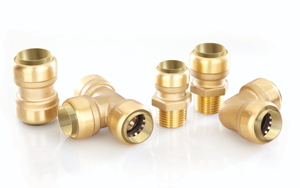Taking the heat off plumbing

With so many press and push fit products on the market, it can be difficult to know which to choose. Bill Barlow of Conex Bänninger offers some guidance.
With so many press and push fit products on the market. The decision on which fittings to choose is based on a number of factors: ease of installation; speed of installation; health and safety issues; cost; and installation limitations. Many of these factors have led to the continued shift away from traditional brazing methods and towards more efficient press and push methods — with both options offering beneficial fitting solutions to installers.
Whilst traditional methods still have their place in the market, the rise of press fitting has in part been driven by an improved installation time (when compared to brazing). Press fittings are up to three times faster than brazing, and they also negate the need to stay on site for hours after installation due to fire risk and health and safety reasons, which can often be the case when working with flame-based fittings.
Health and safety at work is paramount, whatever the industry. To undertake any welding works, the installation company must obtain a hot-works permit in order to legally complete the job. When soldering, there is also a real risk that carbon deposits or flux may be left as a by-product of the installation. By using a press fittings, localised annealing from high-temperature working is also alleviated.
 |
| Heat-free jointing for pipes — press fittings (above) and push fittings (below left). |
Making a correct joint can in some cases be a challenge when using traditional techniques, a factor which is greatly reduced by using press fittings.
One of the stand-out benefits of press fittings, and particularly 3-point press variants, like Conex Bänninger’s >B< Press range, is that they offer an added layer of security and peace of mind for the installer, who is safe in the knowledge that the joint will be correctly sealed.
When installing such a 3-point press fitting, the installer can quickly identify leaks when a joint has been connected and take steps to correct it, negating the need to drain the system down or risk having to return at a later date to fix problem joints.
With the >B< Press range, this safeguard is achieved thanks to a pressing indicator (a specially designed O-ring that has a reduced section in two positions), which, if not pressed properly, will leak at low pressures (from 0.1 to 0.5 bar). When the joint has been pressed correctly, the O-ring seal compresses to form a secure joint.
With traditional methods, there is also a risk that the fitting could be left incomplete if the installer cannot get the solder to flow correctly around the joint, heightening the risk of resulting leaks.
Avoiding leaks is a pre-requisite for any installer, but the choice of fitting can either increase or decrease this risk. It’s because of this that many in the industry worldwide choose 3-point press.
Moving on to push-fit, this technology has been designed to optimise time efficiency, and to help ensure that installers are able to work across jobs more effectively. Unlike press-fit methods, pushfit fittings do not require additional tools for installation. Once the pipes have been measured, cut and deburred, the actual jointing takes just seconds to complete.
 |
Another key benefit of many push fittings, is that the fitting can be easily de-mounted if there has been an error in installation or removal is required — which isn’t the case with press fittings or where traditional methods are concerned.
Importantly, if removal is required, there is only minimal need for additional materials or new pipework; the installer need only remove the existing fitting with the appropriate release tool and replace with a new one, provided the pipe is not damaged. Once the new fitting has been installed the job is complete.
Push-fit fittings are ideal for use in tight spaces. When space is limited there may potentially be a risk that a joint may not be secure if the installer is unable to access the pipes for brazing or to use a press jaw around the fitting — factors which could considerably affect the quality of the joint.
In addition to the many benefits of push-fit solutions, it is important to consider investing in the best possible fittings on the market. Copper and brass solutions are desirable as their strength and durability cannot always be matched by plastic alternatives.
Bill Barlow is UK business unit director for Conex Bänninger







